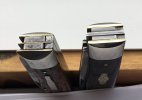- Joined
- Sep 15, 1999
- Messages
- 2,112
Okay flush joints (flush backspring) are not new per se but new to me. I’ve just recently heard of their existence and was wondering what the action was like compared to a traditional slip joint.
not much information on the interwebs about them except it takes great skill to achieve the desired goal ....
not much information on the interwebs about them except it takes great skill to achieve the desired goal ....
Last edited:






